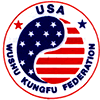Proud
Member
of USAWKF
of USAWKF
|
Martial ArtThere are subtle variations on the history of the advent of martial arts, all agree in the following basic history of the development of the systems of martial arts. A Brief History of Martial ArtsIn the history of kung fu one finds myth, legend and fact. Myths are tales, which weave colorful stories with powerful messages about the human condition. Indeed the history of kung fu begins with a myth.Many years ago at the dawn of human civilization there was a land called the Middle Kingdom. Life there was idyllic. There was peace, harmony and freedom. Men and women followed the Tao, or Way, which is living simply and in harmony with nature and the universe. One moon a hideous beast appeared, twelve feet tall, with scales and horns, and deadly strength. The beast enslaved the inhabitants of Middle Kingdom. Peace and harmony and freedom were lost. The legend tells of a young man so sensitive he could feel the collective pains of humanity. At night while asleep he would dream and in this dream his body would move in strange and different ways. While awake he would practice these movements and soon realized they made his body strong, generated power, unified mind and body and protected life. Using these movements, he engaged the beast in battle and defeated it, and thus discovered kung fu. The inhabitants of Middle Kingdom would again enjoy peace, harmony and freedom. The peace would last one thousand years until another beast began rearing its ugly head. This beast was more subtle, expressing itself as greed for power to dominate and control others. The kung fu that was used to preserve life was now used to take life. Armies were formed. There was slaughter and brutality unlike anything ever seen. Hundreds of thousands of lives were lost. In 221 BC the army of Chin defeated all others and China as a nation was formed. It was not until seven hundred years later when the Shaolin Sanctuary was built that the essence of kung fu was again discovered. The Shaolin Sanctuary was built at the end of the fifth century AD, to serve as a location to translate Buddhist scriptures from India into Chinese. Construction began in the year 495 AD and took twenty-five years to complete. There are many schools of Buddhism which are classified according to two main groups called Theradava and Mahayana. In the year 525 a missionary from India named Bodhidharma traveled to China. He had an audience with the emperor. Their exchange is famous. The emperor was proud of his accomplishments. He then asked Bodhidharma what all his good works did to merit enlightenment. Bodhidharma's reply was, "Absolutely nothing", then walked away. The emperor sat for a while, then felt insulted and asked his soldiers to find Bodhidharma and bring him back. They pursued him to the banks of the Yellow River where legend says Bodhidharma walked across the river leaving the soldiers dumbfounded. To this day Bodhidharma walking across the river is a common theme in east Asian art. Bodhidharma then went to the Shaolin Sanctuary and sat in meditation for nine years in a cave on a hill behind the temple. After emerging from the cave he began teaching. But he found the monks too weak to endure the strenuous meditations he taught. Bodhidharma developed two sets of exercises which were called the "muscle and sinew change" and "the eighteen lohans" Bodhidharma incorporated his understanding of Buddhism with the Taoist philosophy of natural harmony and created a new philosophical school call Chan. Most people are familiar with the Japanese translation of Chan which is Zen. Because this is Hiniyana or "early" Buddhist teaching, and was refuted by the Buddha himself in his last eight years of teaching of the Lotus Sutra, we of the Threefold Lotus Kwoon simply use this as reference for the training of the mind. Our goal at the Kwoon however, is to develop fully our enlightened nature through the practice of the Lotus Sutra. To continue: The muscle and sinew change, and the eighteen lohans combined with the kung fu which already existed and became the foundation of modern kung fu. These exercises underwent continual refinement for many centuries. By the thirteenth century Shaolin Kung Fu was recognized by five subsystems called tiger, dragon, leopard, crane and snake. These five animals each possess distinct forms while serving as metaphors for self-development, tiger for strength, dragon to spirit or passion, leopard to speed and strength, crane to connective tissue and fluidity, and snake to qi (chi). During the seventeenth century China was a invaded by Manchurians from the north. The five Shaolin Systems were further refined with the addition of grabbing techniques. This became known as the Mantis System and Wong Long is credited with its development. In the nineteenth century a Shaolin master named Dong Hai Chuan began teaching an entirely different system called Ba Gua Zhang which is based on the philosophy of the Yi Ching, or Book of Changes. The principles of Ba Gua Zhang are motion and stillness and the underlying principle states that the only constant in this universe is change. For
more information, continue reading the definition of Modern day
Quanshu or Quanfa. |













